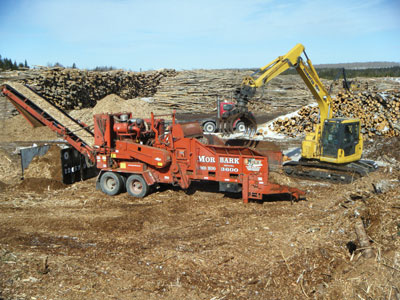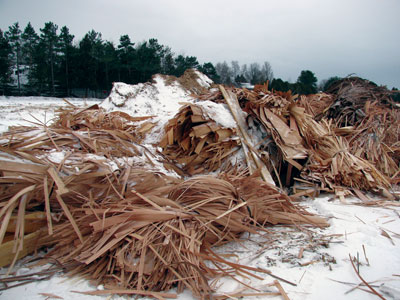
Impure Biomass Thoughts
March 29, 2012
By Mariève Paradis
Alain Grenier and his four employees travel the province with two Morbark 3600 grinders
Alain Grenier and his four employees travel the province with two Morbark 3600 grinders in search of forest biomass. Sometimes called by companies who want to get rid of biomass, sometimes called by others who want to get their hands on some, Estrie Mobile Grinding works in both cases as a middleman.

|
|
| Estrie Mobile Grinding has two 500-hp Morbark grinders working non-stop to cut, chip and grind residuals into biomass.
|
For six years, Alain Grenier has worked in Quebec’s forest biomass sector, an area of the forest industry that he has long believed will eventually explode. It hasn’t been easy, but the contractor is still confident that this nascent industry will take off in the province, so he continues to cut, chip and grind forest operation residual bark and branches, and sawmill yard residues such as stumps, trim blocks and pallets. “I wanted to offer a service to small businesses, those that cannot justify having chippers or grinders on site,” Grenier explains.
Fed by excavators fitted with Rotobec grapples, the two 500-hp Morbark grinders work non-stop, except for regular service intervals in his garage in East Angus, just behind the Cascades containerboard mill in this small town 100 km east of Montreal. The grinders, sold and serviced by Cardinal Equipment, can be kitted with knives or hammers, as required.
Grenier says that selling residual forest biomass as fuel sometimes means a lot of work, as it needs to be dry and clean for the local combustion clients he serves. “This can be a problem. When there’s dirt, sand or metal in the slash, not only does the biomass lose value to potential buyers, but it may damage my equipment on top of that.”
 |
|
| Behind the Masonite plant, mill and forest residues, stumps and pallets are ground two or three times per year.
|
You’ll hear the same story from Antoine Lapierre, yard foreman and head scaler at Masonite International Corporation in Lac-Megantic. Canadian Biomass met both men in this forestry and tourist town near the Maine-Quebec border, and both agreed that the high level of impurities in the current biomass supply is hard on equipment and productivity.
Masonite’s plant in Lac-Mégantic makes the surface layer for wooden doors. To heat the presses and dryers, as well as the plant and the ponds used to condition logs for the lathes, the plant uses biomass made up of bark, wood pallets, mill residues (plywood edgings) and other forest residues.
“With the current technology and improvements in plant efficiency, we no longer produce enough residue to fuel our boilers. We have to buy biomass for heat in winter,” says Lapierre, which is a good problem to have. In total, nearly 3,800 tonnes of biomass are purchased as boiler fuel, with mill residues now accounting for only 50% of the boiler fibre supply.
To create the supplemental supply, Estrie Mobile Grinding brings its equipment to the mill yard two or three times a year. The crew grinds stumps, bark, pallets and other byproducts.
When this mixed bag of biomass contains impurities such as rock and sand, the consequences can be disastrous.
“We need to clean the combustion chamber twice a day to avoid the vitrification of these impurities,” Lapierre explains. Once that happens, the impurities harden and condense to become large blocks of glass. Newer biomass installations have removable floors under the chambers for the regular removal of deposits or “klinkers.”
But at Masonite, the units date back to just after the Second World War, and upgrading is just not in the cards right now. “There is a shortage of biomass at a good price in this region,” Lapierre says. “Still, I cannot afford to take unsuitable forestry residuals. When the log harvests are finished in woods, forestry machinery operators collect the biomass using grapples. If the equipment is not well suited, or the operators not properly trained, or people drive over the residuals first, you’ll get a significant accumulation of soil and sand. It would be good to be able to use that volume in my boilers were it properly harvested.”
Grenier of Estrie Mobile Grinding explains it this way. “Adding some soil or other contaminants in the residual forest biomass is like putting water in the fuel tank of a car … even just a bit and the whole load of biomass may not be marketable as fuel,” which results in such loads being sold as compost instead.
Solutions?
To obtain consistent energy and heat, the men agree that the key remains managing a good ratio of different kinds of biomass. Every material they use – bark, wood pallets, or roots – have its own good and bad sides. The wood must be clean and dry, but not too dry to make it hard to control the heat in the furnaces. Grenier also mentions another solution.
“A biomass grinding or chipping operation should be considered even before the log harvest takes place. Every forgotten or over-looked detail at that stage can increase the cost and time involved in handling, grinding and burning the biomass. It’s far more efficienct and profitable to incorporate the grinding operation in the early harvest planning.”
Still, in this young industry, education and operator training will likely be part of the answer. •
| Competition for residuals Since the early 2000s, the recovery of construction and demolition wood in Quebec has increased by over 780%. According to Recyc-Quebec, Quebec recycled 79,000 tonnes of wood in 2000. By 2006, that amount had grown to more than 621,000 tonnes. One of the reasons for this surge is that sorting centres in the province have smelled a bargain. Wood from construction waste and demolition is clean and dry, and local markets are numerous: Cogeneration, particleboard manufacturing, briquettes for households, litter, pellet fuel, composting, etc. However, these are many of the same markets that use residual forest biomass. Although there is political will to enhance the value of residual forest biomass, the biomass sector across Quebec is still in its infancy. The province currently finds itself with a surplus of biomass products intended for, among other things, energy production. |
Mariève Paradis is the editor of Canadian Biomass’ sister publication, Opérations forestières et de scierie.
Print this page